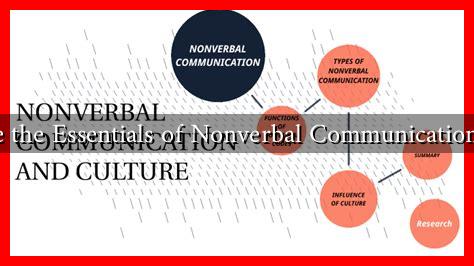-
Table of Contents
What Are the Essentials of Nonverbal Communication in 2025
As we move further into the digital age, the importance of nonverbal communication continues to evolve. By 2025, the landscape of how we convey and interpret nonverbal cues will be shaped by advancements in technology, cultural shifts, and the increasing globalization of communication. This article explores the essentials of nonverbal communication in 2025, highlighting its significance, key components, and the impact of technology on our interactions.
The Significance of Nonverbal Communication
Nonverbal communication encompasses a range of behaviors that convey messages without the use of words. This includes facial expressions, body language, gestures, posture, and even the use of space. According to a study by Mehrabian (1971), nonverbal cues account for approximately 93% of communication effectiveness, with only 7% attributed to spoken words. In 2025, understanding nonverbal communication will be more crucial than ever due to the following reasons:
- Globalization: As businesses expand internationally, the ability to interpret nonverbal cues across different cultures becomes essential.
- Remote Work: With the rise of remote work, nonverbal communication through video conferencing has become a primary mode of interaction.
- Emotional Intelligence: Nonverbal cues are vital for developing emotional intelligence, which is increasingly recognized as a key skill in personal and professional settings.
Key Components of Nonverbal Communication
In 2025, several key components of nonverbal communication will remain essential for effective interaction:
- Facial Expressions: The human face can convey a multitude of emotions. In a world where digital communication is prevalent, understanding facial expressions during video calls will be critical.
- Body Language: Posture and gestures can indicate confidence, openness, or defensiveness. For instance, leaning forward can signal interest, while crossed arms may suggest resistance.
- Proxemics: The use of personal space varies across cultures. In 2025, being aware of these differences will be vital for effective cross-cultural communication.
- Paralanguage: This includes tone, pitch, and volume of voice. The way something is said can often convey more than the words themselves.
The Impact of Technology on Nonverbal Communication
As technology continues to advance, its impact on nonverbal communication is profound. Here are some ways technology is shaping our understanding and use of nonverbal cues:
- Video Conferencing: Platforms like Zoom and Microsoft Teams have become staples in professional settings. The ability to read body language and facial expressions through a screen is essential for effective communication.
- AI and Emotion Recognition: Artificial intelligence is being developed to analyze nonverbal cues. For example, companies like Affectiva are creating software that can detect emotions based on facial expressions, which can enhance customer service and user experience.
- Virtual Reality (VR): VR technology is being used for training in nonverbal communication. Simulations can help individuals practice and improve their nonverbal skills in a controlled environment.
Case Studies and Statistics
Research indicates that effective nonverbal communication can significantly impact business outcomes. A study by the University of California found that teams with high emotional intelligence, which includes strong nonverbal communication skills, performed 20% better than their counterparts. Additionally, a survey by LinkedIn revealed that 85% of professionals believe that nonverbal communication is crucial for building trust in business relationships.
Conclusion
As we approach 2025, the essentials of nonverbal communication will continue to evolve alongside technological advancements and cultural shifts. Understanding the significance of nonverbal cues, mastering key components, and adapting to the impact of technology will be vital for effective communication in both personal and professional contexts. By honing these skills, individuals can enhance their emotional intelligence, foster better relationships, and navigate the complexities of a globalized world.
For further reading on the importance of nonverbal communication, consider exploring resources from the American Psychological Association.


